What to Make of the Unusual Unanimity Towards the End of this SCOTUS Term
We’re seeing unanimity like never before, but will it hold…
A lot of recent chatter about the Supreme Court surrounds the slew of unanimous decisions from the past month (see e.g. Newsweek, Washington Examiner, Slate) and so I decided to dig into whether this set of decisions is notable or if it is par for the course. My quick take is that it is both. This is quite unusual behavior for this time of year and it likely won’t last. Here’s why.
It's Unique
Historically the Court has heard many more cases a term.
Recently the total number of argued and signed decisions across each term has settled in the low 60’s.
This impacts the number of decisions at the end of terms as well, as the graph below looking at the total number of signed and argued decisions from May and June from 1946 through the end of last term shows (votes from previous terms were derived from the U.S. Supreme Court Database).
In recent years half or more of the Court’s total decision output has come in these months. Of course, if recent terms have taught us anything, it is that the Court’s split decision output tends to run high at the end of each term.
That is why this recent glut of unanimous opinions piqued my interest as well as others’. With 20 decisions left in this term, there are still many opportunities for split decisions, especially those along ideological lines.
Historically there has been a good deal of variation in the number and frequency of unanimous opinions at the end of each term. First a look at the raw count of unanimous opinions in May and June of each term.
The 10 unanimous decisions in May and June last term was substantially lower than the 18 the previous term. There were only five decisions released in May of this term though compared to 11 last term. And 15 the term before. This variation may play into the number of unanimous opinions although the low count of May decisions this term would suggest that the split between May and June decisions is not determinative of the number of unanimous decisions before the end of June.
Looking at the percentage of unanimous decisions from May and June of each term we see the following.
While the frequency of unanimous decisions in May and June was down last term, the percentage has bounced around from near 30% to the mid-40%’s in recent terms and even exceeded 50% in both the 2013 and 2016 terms (2016 was without the benefit of a ninth justice for most of the term even though Gorsuch joined for the end of that Term).
This term there were 17 decisions so far in May and June. Three of those were unsigned making for 14 argued and signed decisions so far at the end of this term with 12 of these by unanimous votes. Here is how this compares to previous terms
What is special about this Supreme Court Term? The most unanimous decisions of the first 14 signed decisions in May and June since 1946 was 10. This term there were 12.
Next, if we pin down the number of dissent votes from the first 14 May/June decisions each term we see the following totals:
The previous low point of 12 dissent votes within the timeframe since Roberts joined as Chief Justice in 2005 was during the 2017 terms and is six times more than the two dissent votes from May and June so far this term.
Gorsuch Dissents
Both of the dissent votes of the 14 decisions so far in May or June were solo dissents from Justice Gorsuch (in Parrish and Zuch). Gorsuch notably only solo dissented five times total prior to this Term.
Gorsuch’s two solo dissents so far this term isn’t setting any records yet though.
Justices Thomas and Stevens both had more solo dissents in May and June of previous terms. Thomas had five in one term while Stevens had four several times. The anomalous Justice Douglas set the records for the most solo dissents at the end of a term with eight but he was idiosyncratic in this regard.
If we narrow the set of cases to the first 14 signed decisions in May and June of a term, solo dissents look as follows:
Since the early 1960’s the only justices with more than two solo dissents of the first 14 signed decisions in May and June of a Term were Justices Thomas and Stevens, two of the most prolific dissenters across the Court’s history.
We’ve seen unique unanimous behavior from the Roberts Court in the past though. This term’s behavior may be an aberration, and things will probably level out before the term is through. Still, this showcases how even with a divided Court and an output that tends to be more contentious towards the end of terms, the justices have reached a striking amount of consensus so far. This cuts against the narrative of a fractured Court and may have to do with a softer middle than previously assumed and also may relate to unique judicial behavior rather than what previously appeared to be a clear 6-3 conservative supermajority.
What’s Coming
Ideological fractures and dissenting votes are assuredly going to increase while corresponding unanimous decisions will decrease as the justices issue their final 20 decisions of the 2024/2025 Term.
Past patterns and institutional norms help strengthen this supposition. The Chief Justice tends to assign an equal (or near equal) number of majority opinions to each justice across the entire term and generally allots an equal number of majority opinions to each justice within the decisions from each argument sitting from October through April.
One prerequisite for ideologically split decisions is that one of the six conservative justices must be the majority author. The only justices with five opinions so far this term are Sotomayor and Kagan. Jackson has four along with all other justices aside from Kavanagh and Roberts who both have only authored three so far. This is the first hint that the conservative justices will author more opinions at the end of this term than the liberal justices, even accounting for the 2:1 ratio of conservative to liberal justices on the Court.
One of the likely candidates for an ideological split is the Skrmetti decision on gender affirming care for minors. This is the only December argument yet to be decided and the only justices yet to author for this sitting are Roberts and Thomas.
There are six cases yet to be decided from the January sitting. Jackson is the only liberal justice left without an opinion from that sitting along with Justices Thomas, Kavanaugh, Gorsuch, and Barrett from the Court’s conservative wing.
There are four cases left undecided from the February sitting and Sotomayor is the only liberal justice without a majority opinion from that sitting along with Justices Roberts, Kavanaugh, Gorsuch, and Barrett.
The March sitting is similar since even though there are seven cases so far undecided, the remaining justices without a majority opinion from that sitting are Kagan from the liberal side and Thomas, Roberts, Alito, Gorsuch, Barrett, and Kavanaugh from the right.
The only sitting with an even split of justices from both ideological ends of the Court left without majority opinions is April (and May for the Casa case). With four cases left, Alito, Kagan, Kavanaugh, and Jackson have yet to author.
While the norm of near equal assignments across the entire term and within each sitting is that: only a norm, it generally holds true, or at least nearly so. That bodes well for more split decisions at the end of the term and especially for at least a few of these along ideological lines.
At the end of the day this term’s finale will likely have a mix of the unexpected in terms of solo dissents and unanimity, at least at the beginning of May and June, and a typical end of the Term, at least since the mid 20-teens, where the balance of decisions either go down along ideologically split lines or have majorities composed mainly of the conservative justices.
Note: Since several of my recent posts have dealt with the Supreme Court, I’ll try to balance out with non-SCOTUS material before the mad rush at the end of this Supreme Court Term.
If you enjoy this material please subscribe. Paying subscribers help drive the research on this Substack. Feel free to comment below.




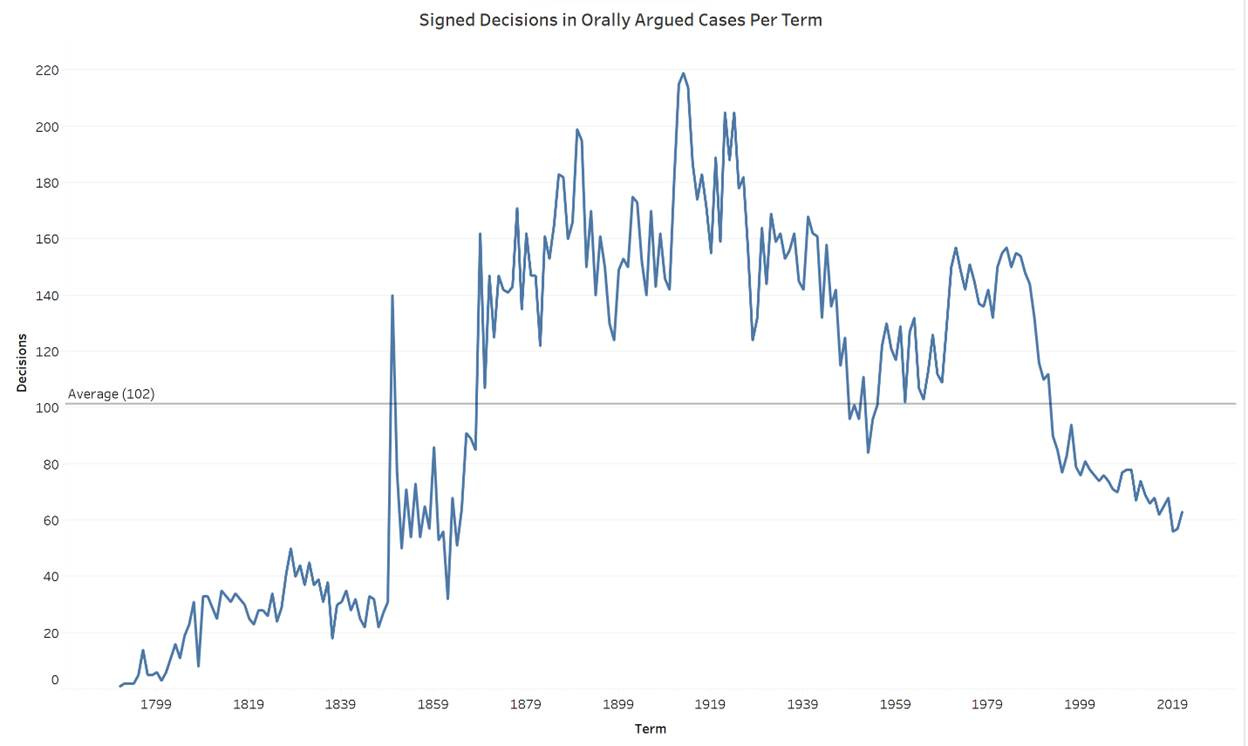
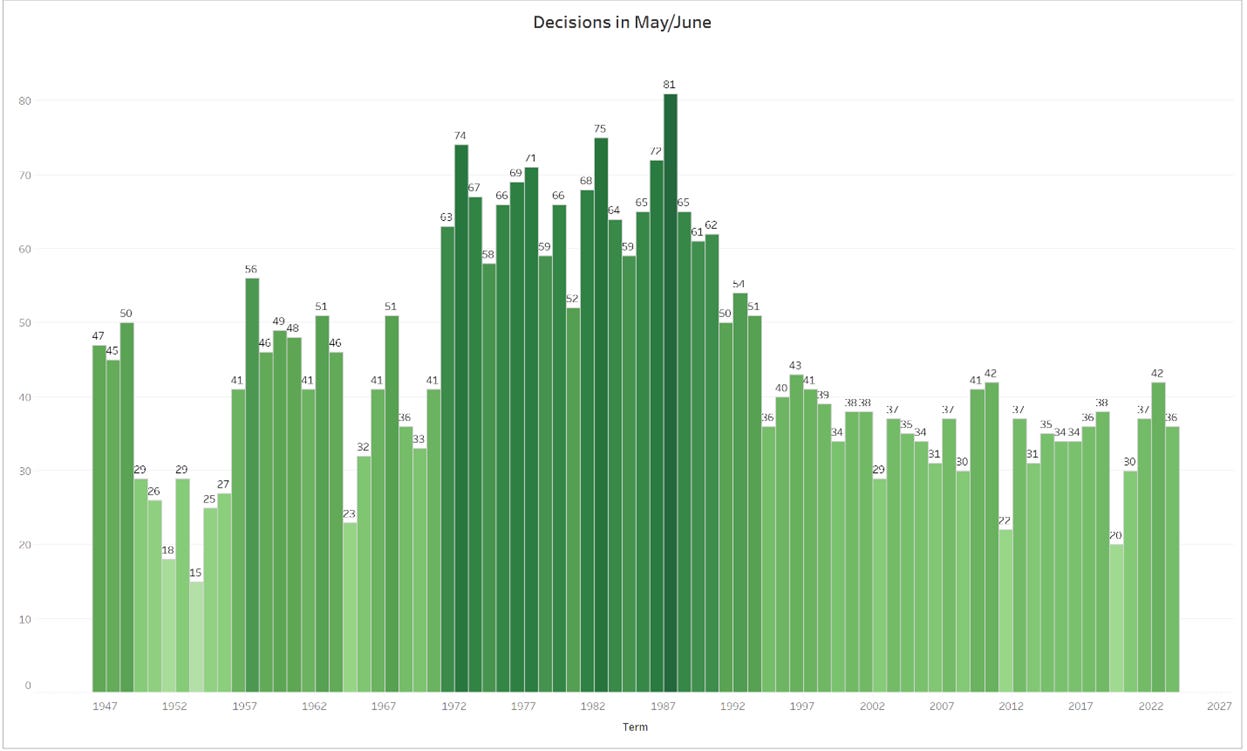
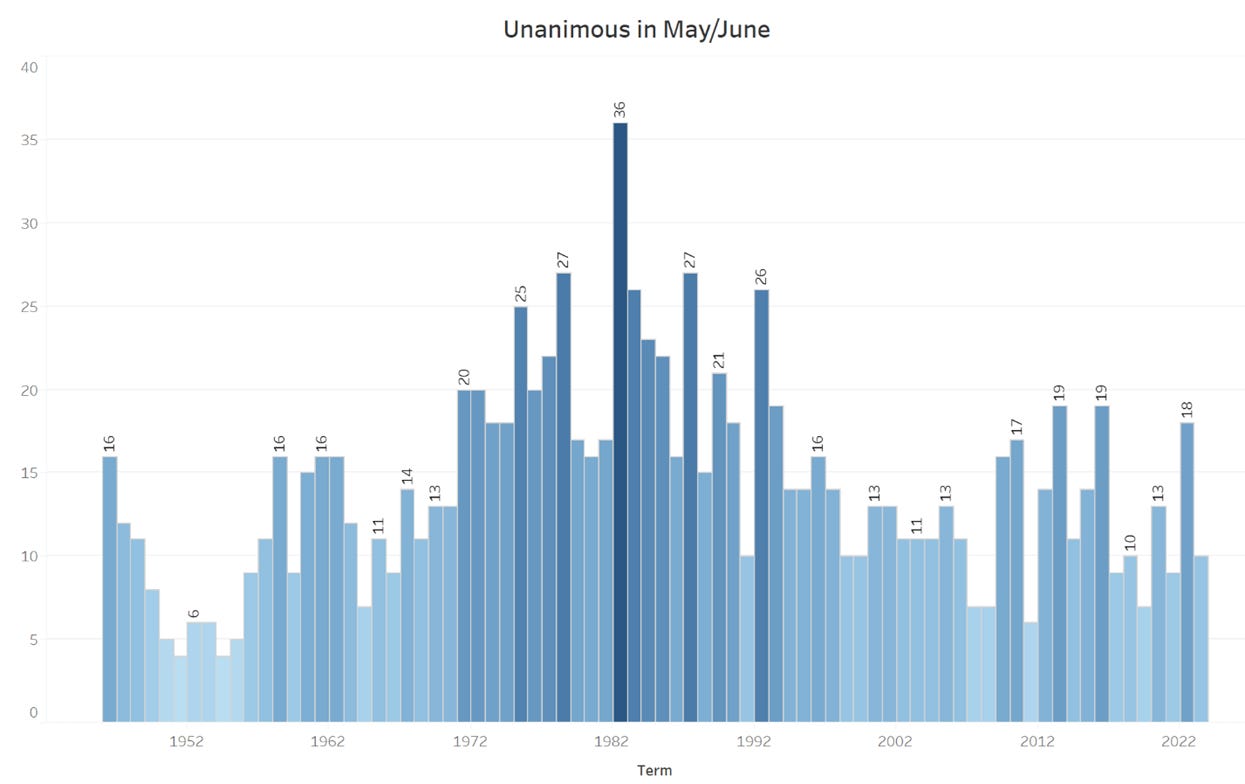
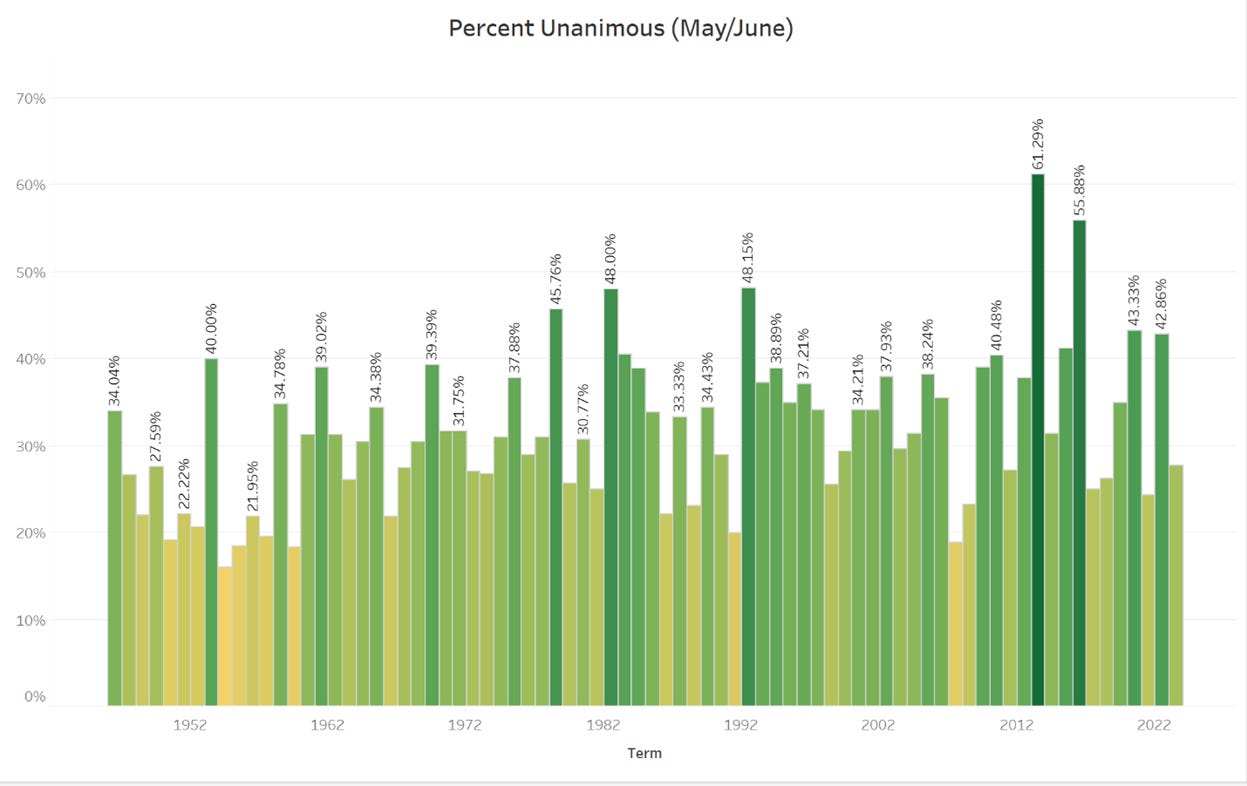
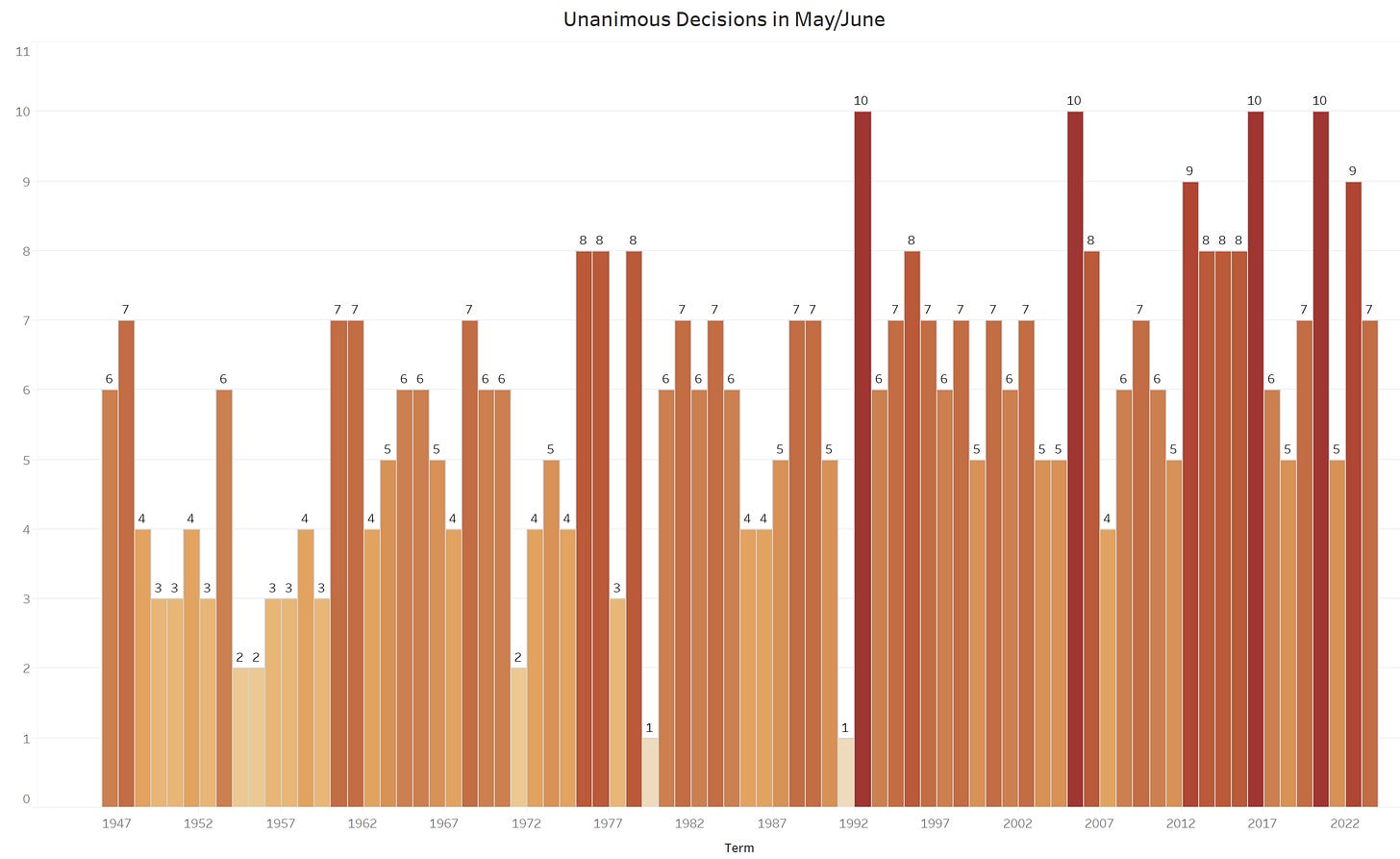
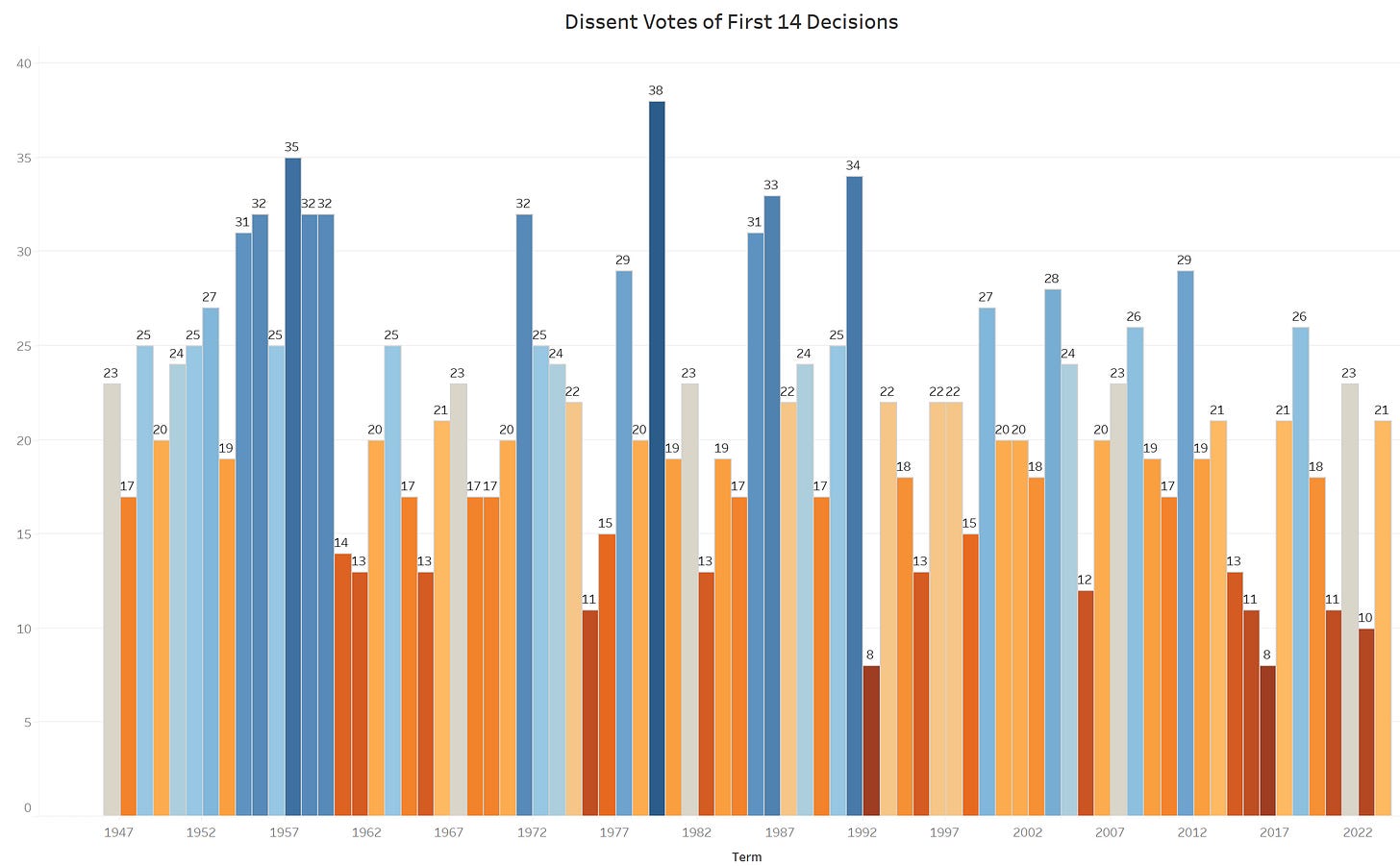


Another excellent analysis! I’d add more … but I’m still waiting (almost patiently) for Chief Justice Roberts to assign me an opinion …